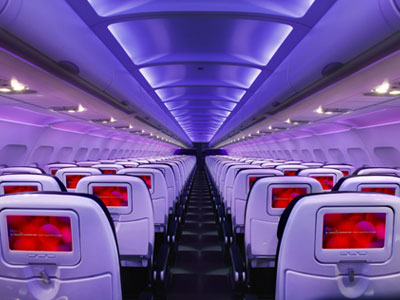The Inside Scoop On In-Flight Lights
After safety, passenger comfort is an airline’s top priority. Research shows how the proper use of cabin illumination can improve your flight experience. Airlines control the mood and ambiance onboard by changing colors and light intensity. For example, a mood-setting function with colored accents provides passengers with a relaxing transition between cabin lighting phases. Cabin sidewall and ceiling lights provide smooth light effects. Using OLED lighting, which is soft and diffused, aircraft designers, will have more options. Manufacturers have been creating innovative lighting and projection systems for several years that allow their customers to customize the passenger experience.
What is one to do if you wish to stay awake once the cabin lights dimmed? The reading spotlight is available above each passenger seat and uses fiber optic and LED technology to allow passengers to adjust the intensity of the light as needed without bothering their neighbors. Furthermore, the lighting can artificially shorten the day during the flight so that passengers can acclimate to their destination’s new time zone. Have you ever needed to find your way to the restroom in the middle of an overnight flight? In that case, you can thank the contour lighting, which accentuates the aisle, seats, overhead bins, and other cabin features for effortless navigation.
These simple yet essential lighting features require instruments that measure LED and display measurement. These measurements include luminance, flux, intensity, illuminance, and chromaticity of LEDs, lamps, and displays throughout all aspects of product development and production.
Interior lighting conditions can affect the visibility of both installed displays and passengers’ devices. But interior lighting isn’t only for passengers; it is also a vital component in the cockpit. Interior lighting provides illumination for instruments, cockpits, cabins, and other sections occupied by crewmembers and passengers. Certain special lights, such as indicator and warning lights, indicate the operation status of equipment.
Control panels located on the lower center pedestal include knobs to control functions such as intensity of the primary and multifunction flight displays, which provide flight information, integral lighting for the instrument panel and side panel, floodlighting, and floor lighting.
Cockpit instrumentation has also evolved over the past decades. In the past, control panels had backlit gauges, switches, and knobs, where now you are more likely to see an array of flat panel screens. There must be consistent light and color emitting from these panels to reduce eyestrain, ease interpretation of data, and decrease distractions. In addition, they are comfortable to view equally in daylight and at night.
Measuring display performance parameters such as luminance and color uniformity, gamma, contrast ratio, and color gamut comprehensively detects subtle flaws.
Two key measurements are Luminance (a measure of brightness) and Display Contrast (the ratio between light and dark).
When you measure contrast, it is best to use a spectroradiometer such as the CS-3000. With high-end spectroradiometers, you can measure the darkest blacks down to super-low luminance of 0.003cd/m2 allowing measurements up to 1,000,000:1.
To measure luminance, you can use a luminance meter such as the LS-150 or LS-160.
Advances in display technology within the aerospace industry give high expectations on cockpit display quality. Evaluating the quality and performance of displays needs to be clearly and accurately conveyed to pilots.
Displays must maintain legibility during the day and night time and at a range of viewing angles. The passenger’s experiences and the pilot’s operations are undoubtedly affected by the state of interior lighting. With new technologies on the horizon, interior lighting will continue to transform the airline industry. Visit our industry aerospace resource page to see our entire portfolio of products related to the aerospace industry.











